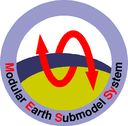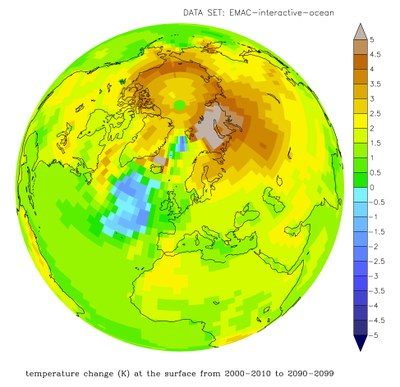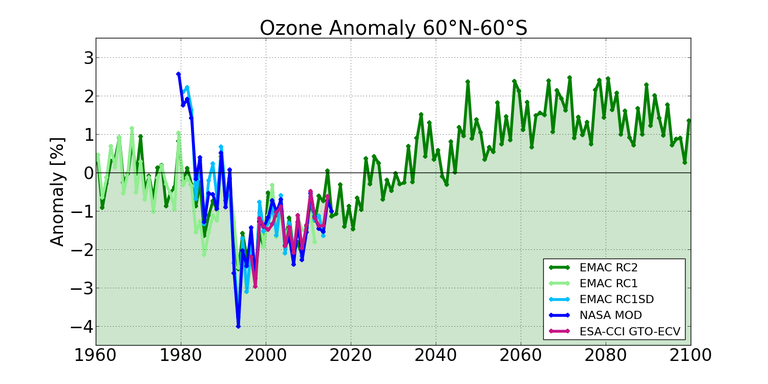 The study of chemistry-climate interactions represents an important and, at the same time, difficult task in scientific research. The emerging issues of climate change, ozone depletion and air quality are challenging from both scientific and policy perspectives. It is crucial to understand how the chemistry and composition of the atmosphere have changed over the last 100 years and how they may change throughout the 21st century in order to prepare adequate adaptive responses and to develop mitigation strategies.
The study of chemistry-climate interactions represents an important and, at the same time, difficult task in scientific research. The emerging issues of climate change, ozone depletion and air quality are challenging from both scientific and policy perspectives. It is crucial to understand how the chemistry and composition of the atmosphere have changed over the last 100 years and how they may change throughout the 21st century in order to prepare adequate adaptive responses and to develop mitigation strategies.
The ESCIMo (Earth System Chemistry integrated Modelling) simulations (Jöckel et al., 2016) were planned in view of special scientific questions with respect to changes in the stratosphere and its related influence on climate change. These topics are treated e.g. within the national project of the DFG-research group SHARP (Stratospheric Change and its Role for Climate Prediction). Further simulations have been carried out in support of the upcoming WMO/UNEP‘s (World Meteorological Organization – United Nations Environment Programme) assessment of the development of the ozone layer and the IPCC ‘s (International Panel of Climate Change) climate assessments, which also will help answering emerging science questions as well as improving process understanding. Moreover, further scenario and sensitivity studies support the Chemistry–Climate Model Initiative (CCMI) that compares and evaluates a large number of chemistry-climate models (Morgenstern et al., 2017).
A special feature of the chemistry-climate model EMAC is a detailed description of atmospheric chemistry. Changes in the chemical composition of the atmosphere feed back to atmospheric dynamics. In addition to simulations with prescribed ocean conditions, EMAC was also coupled with an ocean model. Figure 1 shows the simulated change in the surface temperature for a scenario with a higher CO2 increase (RCP6.0).

Figure 1: Development of surface temperature (K) in the simulation with an interactive ocean for the scenario RCP6.0. The difference is the mean value of the decade: (2090-2099) minus (2000-2010). (Source: Sabine Brinkop, DLR).
The simulations were performed by the ESCiMo initiative, a consortium of national and international scientists of eight research centers and universities. The simulations used more than 6 million CPU hours on DKRZ’s supercomputer and resulted in approximately 2 petabytes of climate data that had to be stored.
The following first results were extracted from recently published articles using the output data of the ESCiMo simulations:
Stratospheric ozone is of major importance for life on Earth as this gas absorbs the harmful UV radiation within the ozone layer of the stratosphere. We know that emissions of chlorofluorocarbons are one of the major causes for the thinning of the ozone layer. Long-term simulations (1960-2100) of the ESCiMo project show that the ozone layer depletion progressed rapidly after 1980. However, they also show that the layer will recover after the year 2035. This result confirms the success of the radical measures of prohibiting ozone-depleting substances through the Montreal Protocol. Additionally, climate change-induced stratospheric cooling seems to accelerate the recovery of the ozone layer on an average global scale (see figure 2).

Figure 2: Anomalies of the total ozone column with respect to the years 1960-1980. Three long-term simulations of EMAC (1960-2100) are compared with the observations of American and European satellite instruments (1980- today) operated by NASA and ESA, respectively. These observational data are harmonized time series from different gauges. (Figure: Melanie Coldewey-Egbers, DLR)
Ozone is also a strong greenhouse gas, but its climatic importance is particularly strong in the troposphere. Yet, tropospheric ozone is inhomogeneously distributed and regionally controlled by the intrusion of stratospheric ozone-rich air. In the eastern Mediterranean and in the Middle East, tropopause folds and the corresponding intrusion of stratospheric ozone provide a significant contribution to the high concentrations of ozone in the middle free troposphere (Aktritidis et al., 2016).
Over the Himalayas, so-called secondary ozone peaks, layers with strongly enhanced ozone concentration in the middle troposphere, are formed by transport from the stratosphere to the troposphere. Accounting for 26% of the ozone budget, this transport provides a significant contribution. Ozone-rich air is transported from Northern Africa, the North- Atlantic, the Middle East, Afghanistan and Pakistan. This transport is strongest during the pre-monsoon period (Ojha et al., 2017).
The comparison of ESCiMo simulations with on-board measurements of the HALO aircraft (High Altitude and LOng range) in the region of the Asian summer monsoon shows that ozone-rich air in the outer southern region of the anticyclone is indeed entrained from a stratosphere-influenced tropopause layer (Gottschaldt et al., 2017). The air masses with increased ozone concentrations were measured after the passage of the southern edge of the anticyclone. This result contradicts earlier studies, wherein ozone-poor air was attributed to uplifts within the anticyclone.
Water vapor is a very important greenhouse gas. The individual factors influencing the distribution and variability of water vapor in the lower stratosphere are not fully understood. The tropopause temperature is one of those factors. A warming of the stratosphere due to large volcanic eruptions leads to higher tropopause temperatures. This effect resulted in an increase in stratospheric water vapor after the eruptions of El Chichón and Mt. Pinatubo (Löffler et al., 2016). The relationship of strongly reduced water vapor entry into the stratosphere and preceding El Niño events, which also have a strong influence on tropopause temperatures, was investigated by Brinkop et al. (2016).
The future influence of tropospheric dynamics on the distribution of the toxic carbon monoxide (CO) was investigated by Bacer et al. (2016). CO is a byproduct of incomplete combustion, for instance in road traffic. For the future, Bacer et al. predict that the center of the North Atlantic Oscillation (NAO) will shift northeastwards and that the NAO will have a slightly positive trend. Subsequently, the southwesterly Mediterranean and North Africa will likely be influenced by stronger CO concentrations during positive NAO phases. However, large parts of Northern Europe will experience less pollution.
Eckstein et al. (2017) confirmed with the help of the ESCiMo simulations that climatologies of trace gases, measured on board of long-range aircraft in the framework of the IAGOS-CARIBIC project, are indeed representative of the actual state of the atmosphere.
The unique data sets from the ECSiMo project have by far not been analyzed completely. They provide a basis to answer a variety of further scientific questions. The simulation results will be made available for further research to the international scientific community via the CERA database (Climate and Environmental Retrieval and Archive). In addition, a subset of the data will be submitted to the British Atmospheric Data Centre (BADC) database for the CCMI project for further analysis and comparison with other model results.
Project partners of ESCiMo:
- Institute of Atmospheric Physics, German Aerospace Center, Oberpfaffenhofen (DLR-IPA)
- Karlsruhe Institute of Technology, Institute for Meteorology and Climate Research - Atmospheric Trace Gases and Remote Sensing (KIT-IMK-ASF)
- Steinbuch Centre for Computing - Simulation Lab Climate and Environment (KIT-SCC-SLC)
- Institute for Energy and Climate Research - Stratosphere, Forschungszentrum Jülich (FZJ-IEK-7)
- Institute of Meteorology, Freie Universität Berlin (FUB)
- Institute of Atmospheric Physics, Johannes-Gutenberg Universität Mainz (UMZ-IPA)
- Max-Planck Institute for Chemistry, Mainz (MPIC)
- Energy, Environment and Water Research Center, Cyprus Institute (CYI)
Further information on the website of the project: http://www.pa.op.dlr.de/~PatrickJoeckel/ESCiMo/.
Contact:
Dr. Patrick Jöckel, German Aerospace Center (DLR) within the Helmholtz Association: UGF0cmljay5Kb2Vja2VsQGRsci5kZQ==
Dr. Sabine Brinkop, German Aerospace Center (DLR) within the Helmholtz Association: c2FiaW5lLmJyaW5rb3BAZGxyLmRl
Press release:
DLR press release, 5th April 2017
Online version with figures and related weblinks: www.dlr.de/dlr/desktopdefault.aspx/tabid-10293/427_read-21966/year-all/#/gallery/26759
Publication:
Akritidis, D., Pozzer, A., Zanis, P., Tyrlis, E., Škerlak, B., Sprenger, M., and Lelieveld, J.: On the role of tropopause folds in summertime tropospheric ozone over the eastern Mediterranean and the Middle East, Atmos. Chem. Phys., 16, 14025-14039, doi:10.5194/acp-16-14025-2016, 2016.
Bacer, S., Christoudias, T., and Pozzer, A.: Projection of North Atlantic Oscillation and its effect on tracer transport, Atmos. Chem. Phys., 16, 15581-15592, doi:10.5194/acp-16-15581-2016, 2016.
Beirle, S., Hörmann, C., Jöckel, P., Liu, S., Penning de Vries, M., Pozzer, A., Sihler, H., Valks, P., and Wagner, T.: The STRatospheric Estimation Algorithm from Mainz (STREAM): estimating stratospheric NO2 from nadir-viewing satellites by weighted convolution, Atmos. Meas. Tech., 9, 2753-2779, doi:10.5194/amt-9-2753-2016, 2016.
Brinkop, S., Dameris, M., Jöckel, P., Garny, H., Lossow, S., and Stiller, G.: The millennium water vapour drop in chemistry–climate model simulations, Atmos. Chem. Phys., 16, 8125-8140, doi:10.5194/acp-16-8125-2016, 2016
Cai, D., Dameris, M., Garny, H., Bunzel, F., Jöckel, P., and Graf, P.: Stratospheric Variability at a glance – Analysis of the intra decadal timescale and the QBO, Atmos. Chem. Phys. Discuss., doi:10.5194/acp-2016-870, in review, 2016.
Dietmüller, S., Garny, H., Plöger, F., Jöckel, P., and Duy, C.: Effects of mixing on resolved and unresolved scales on stratospheric age of air, Atmos. Chem. Phys. Discuss., doi:10.5194/acp-2016-1144, in review, 2017.
Eckstein, J., Ruhnke, R., Zahn, A., Neumaier, M., Kirner, O., and Braesicke, P.: An assessment of the climatological representativeness of IAGOS-CARIBIC trace gas measurements using EMAC model simulations, Atmos. Chem. Phys., 17, 2775-2794, doi:10.5194/acp-17-2775-2017, 2017.
Gottschaldt, K.-D., Schlager, H., Baumann, R., Bozem, H., Eyring, V., Hoor, P., Jöckel, P., Jurkat, T., Voigt, C., Zahn, A., and Ziereis, H.: Trace gas composition in the Asian summer monsoon anticyclone: A case study based on aircraft observations and model simulations, Atmos. Chem. Phys. Discuss., doi:10.5194/acp-2016-997, in review, 2017.
Jöckel, P., Tost, H., Pozzer, A., Kunze, M., Kirner, O., Brenninkmeijer, C. A. M., Brinkop, S., Cai, D. S., Dyroff, C., Eckstein, J., Frank, F., Garny, H., Gottschaldt, K.-D., Graf, P., Grewe, V., Kerkweg, A., Kern, B., Matthes, S., Mertens, M., Meul, S., Neumaier, M., Nützel, M., Oberländer-Hayn, S., Ruhnke, R., Runde, T., Sander, R., Scharffe, D., and Zahn, A.: Earth System Chemistry integrated Modelling (ESCiMo) with the Modular Earth Submodel System (MESSy) version 2.51, Geosci. Model Dev., 9, 1153-1200, doi:10.5194/gmd-9-1153-2016, 2016.
Lennartz, S. T., Marandino, C. A., von Hobe, M., Cortes, P., Quack, B., Simo, R., Booge, D., Pozzer, A., Steinhoff, T., Arevalo-Martinez, D. L., Kloss, C., Bracher, A., Röttgers, R., Atlas, E., and Krüger, K.: Direct oceanic emissions unlikely to account for the missing source of atmospheric carbonyl sulfide, Atmos. Chem. Phys., 17, 385-402, doi:10.5194/acp-17-385-2017, 2017.
Löffler, M., Brinkop, S., and Jöckel, P.: Impact of major volcanic eruptions on stratospheric water vapour, Atmos. Chem. Phys., 16, 6547-6562, doi: 10.5194/acp-16-6547-2016, 2016.
Morgenstern, O., Hegglin, M. I., Rozanov, E., O’Connor, F. M., Abraham, N. L., Akiyoshi, H., Archibald, A. T., Bekki, S., Butchart, N., Chipperfield, M. P., Deushi, M., Dhomse, S. S., Garcia, R. R., Hardiman, S. C., Horowitz, L. W., Jöckel, P., Josse, B., Kinnison, D., Lin, M., Mancini, E., Manyin, M. E., Marchand, M., Marécal, V., Michou, M., Oman, L. D., Pitari, G., Plummer, D. A., Revell, L. E., Saint-Martin, D., Schofield, R., Stenke, A., Stone, K., Sudo, K., Tanaka, T. Y., Tilmes, S., Yamashita, Y., Yoshida, K., & Zeng, G.: Review of the global models used within phase 1 of the Chemistry–Climate Model Initiative (CCMI), Geoscientific Model Development, 10, 639–671, doi: 10.5194/gmd-10-639-2017, http://www.geosci-model-dev.net/10/639/2017/ (2017).
Ojha, N., Pozzer, A., Akritidis, D., and Lelieveld, J.: Secondary ozone peaks in the troposphere over the Himalayas, Atmos. Chem. Phys. Discuss., doi: 10.5194/acp-2016-908, in review, 2017.
